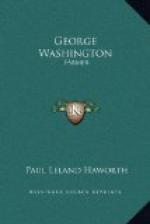This same spring our Farmer records planting ivy, limes and lindens sent by his good friend Governor Clinton of New York; lilacs, mock oranges, aspen, mulberries, black gums, berried thorns, locusts, sassafras, magnolia, crabs, service berries, catalpas, papaws, honey locusts, a live oak from Norfolk, yews, aspens, swamp berries, hemlocks, twelve horse chestnut sent by “Light Horse Harry” Lee, twelve cuttings of tree box, buckeye nuts brought by him the preceding year from the mouth of Cheat River, eight nuts from a tree called “the Kentucke Coffee tree,” a row of shell bark hickory nuts from New York, some filberts from “sister Lewis.” His brother John sent him four barrels of holly seeds, which he sowed in the semicircle north of the front gate; in the south semicircle, from the kitchen to the south “Haw ha!”; and from the servants’ hall to the north “Haw ha!”
Nor did he neglect more utilitarian work, for in April he grafted many cherries, pears and other fruit trees. Such work was continued at intervals till his death.
In raising fruit, as in many other things, he was troubled by the thieving propensities of the slaves. September tenth of this year he records that because of the scarcity of apples and the depredations that were being committed “every Night upon the few I have, I found it necessary (tho much too early) to gather and put them up for Winter use.”
The spring of 1785 proved an exceptionally dry one and he was forced to be absent from home several days, leaving the care of the trees and shrubs to his careless lazy servants. He records that they said that they watered them according to directions, but he seems to doubt it. At all events, “Most of my transplanted trees have a sickly look.—The small Pines in the Wilderness are entirely dead.—The larger ones in the Walks, for the most part appear to be alive (as yet)—almost the whole of the Holly are dead—many of the Ivy, wch. before looked healthy & well seem to be declining—few of the Crab trees had put forth leaves; not a single Ash tree has unfolded its buds; whether owing to the trees declining or any other cause, I know not.... The lime trees, which had some appearance of Budding when I went away, are now withering—and the Horse chestnut & Tree box from Colo. Harry Lee’s discover little signs of shooting.—the Hemlock is almost entirely dead, & bereft of their leaves;—and so are the live Oak.—In short half the Trees in the Shrubberies & many in the Walk are dead & declin[in]g.”
Nevertheless he refused to be discouraged and proceeded to plant forty-eight mahogany tree seeds brought by his nephew, George A. Washington, from the West Indies. He also set out a “Palmetto Royal” in the garden and sowed or planted sandbox trees, palmettos, physic nuts, pride of Chinas, live oaks, accacias, bird peppers, “Caya pepper,” privet, guinea grass, and a great variety of Chinese grasses, the names of which, such as "In che fa,” “all san fa” “se lon fa," he gravely set down in his diary.




